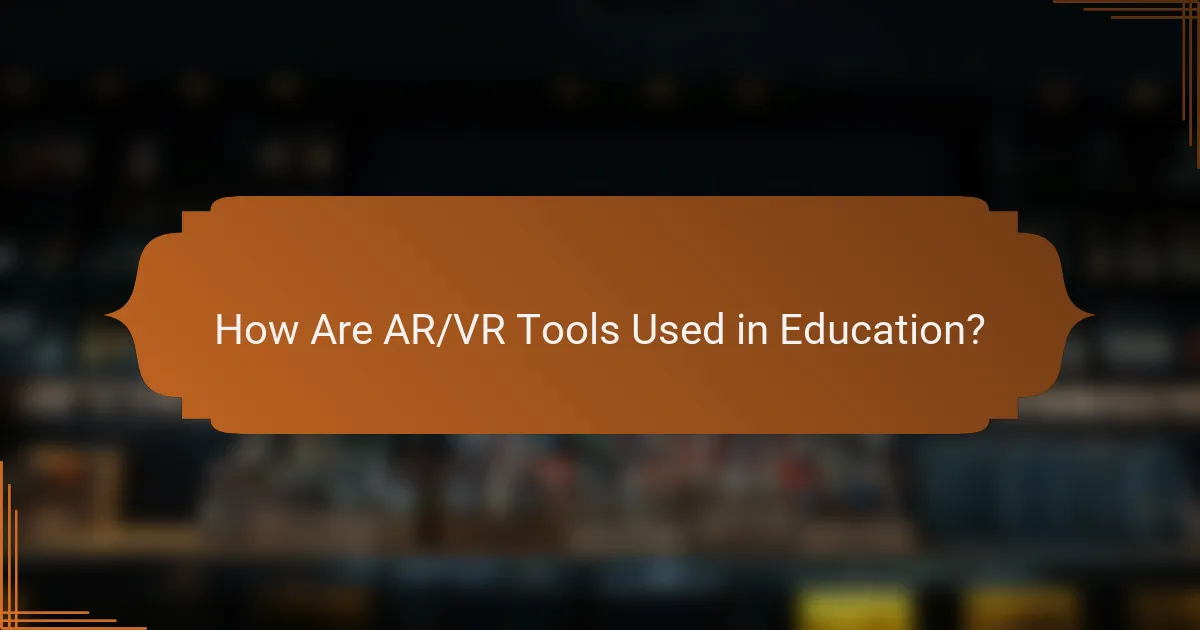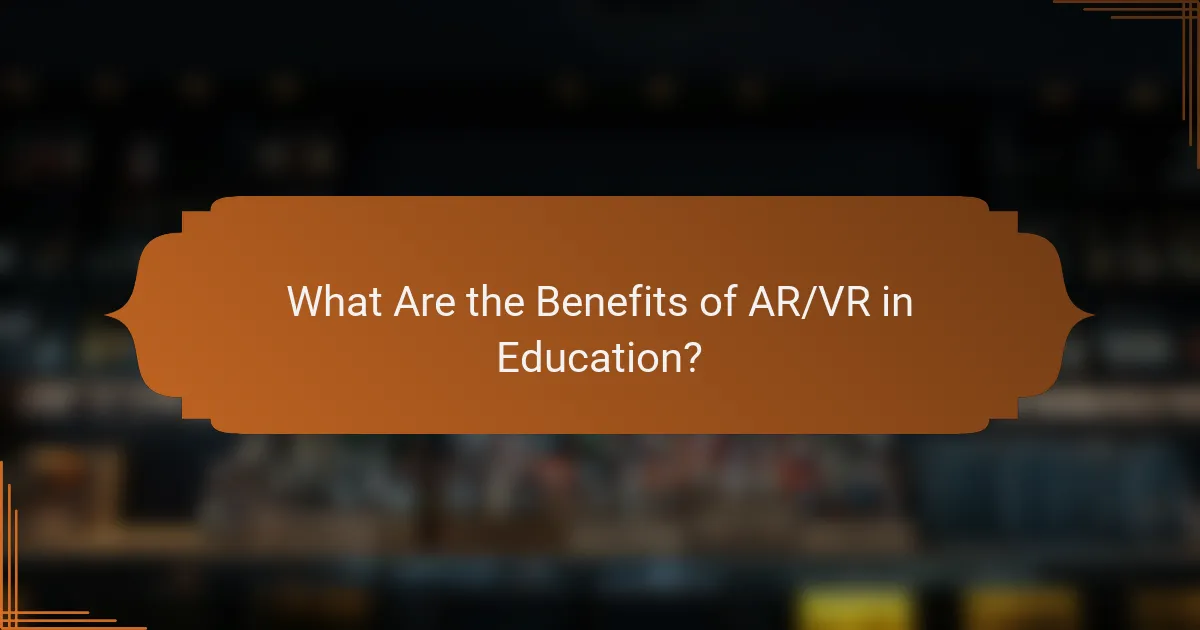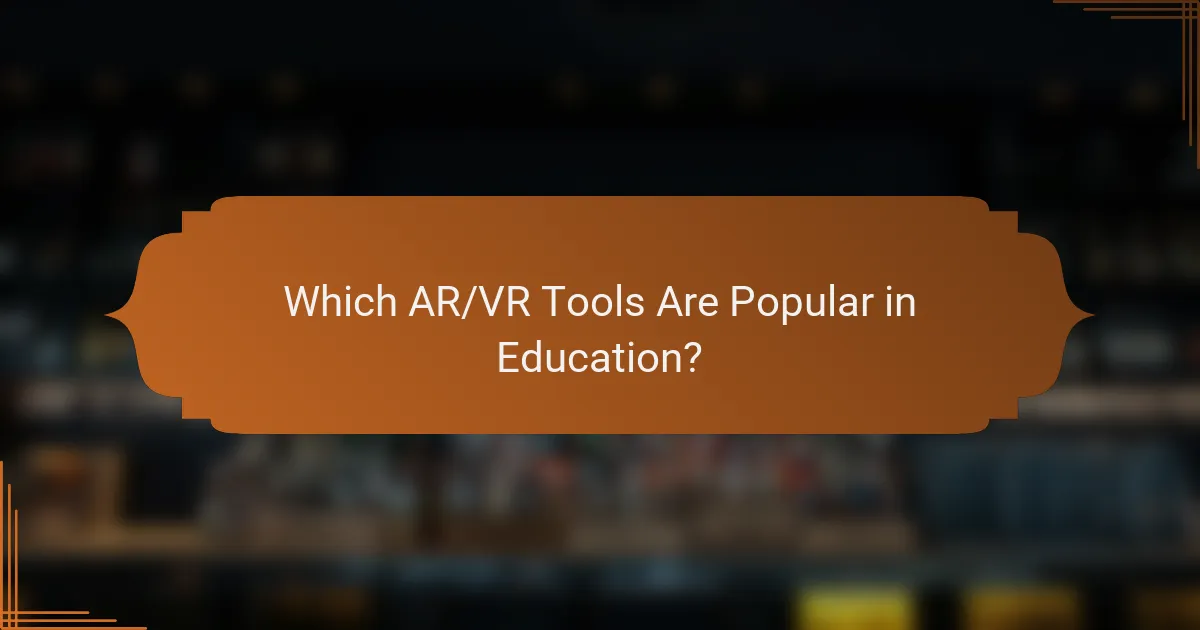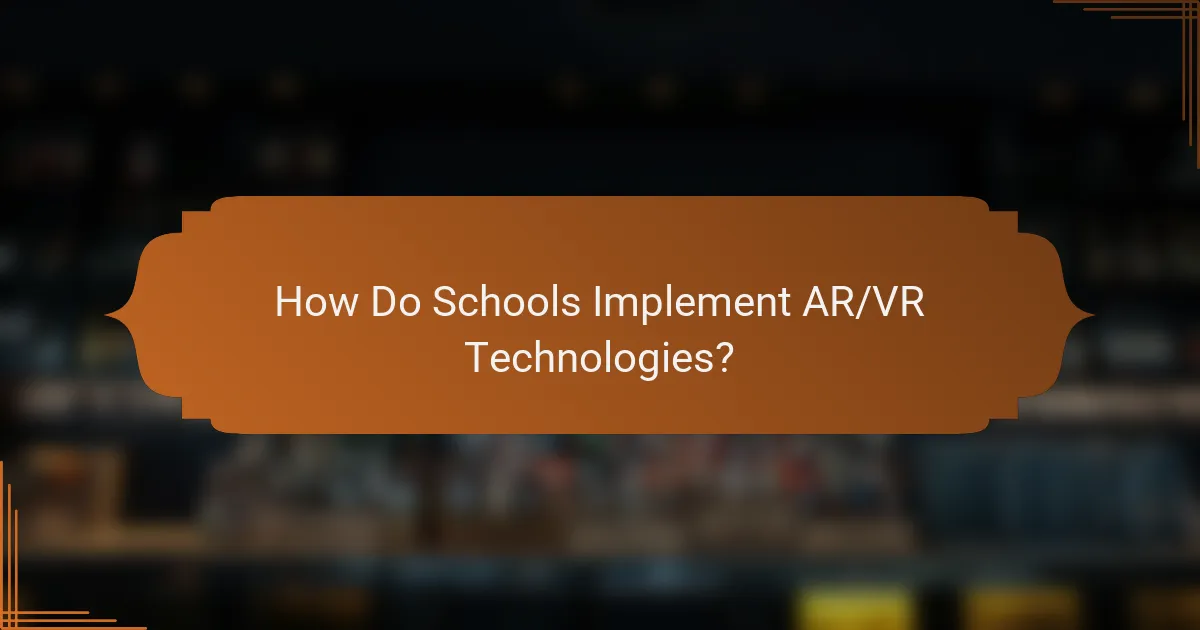Augmented Reality (AR) and Virtual Reality (VR) are transforming educational landscapes by providing immersive experiences that enhance learning. These innovative tools not only boost student engagement and information retention but also cater to diverse learning styles, making education more accessible and personalized. With a variety of applications available, such as Google Expeditions and Nearpod, educators can create interactive environments that foster deeper understanding and enjoyment of complex subjects.

How Are AR/VR Tools Used in Education?
AR and VR tools are increasingly integrated into educational settings to enhance learning through immersive experiences. These technologies facilitate interactive engagement, making complex subjects more accessible and enjoyable for students.
Interactive Learning Experiences
Interactive learning experiences leverage AR and VR to create engaging educational content that encourages active participation. For instance, students can manipulate 3D models in real-time, allowing them to explore concepts like anatomy or physics in a hands-on manner.
These tools can also adapt to different learning styles, catering to visual, auditory, and kinesthetic learners. By providing immediate feedback and interactive elements, educators can enhance retention and understanding of the material.
Virtual Field Trips
Virtual field trips allow students to explore distant locations and historical sites without leaving the classroom. Using VR headsets, learners can visit places like the Louvre in Paris or the Great Wall of China, gaining insights that would be difficult to achieve through traditional methods.
These experiences can be particularly beneficial for schools with limited budgets or resources, as they eliminate travel costs while providing rich, contextual learning opportunities.
Simulations for Skill Development
Simulations powered by AR and VR are effective for developing practical skills in fields such as medicine, engineering, and aviation. For example, medical students can practice surgeries in a risk-free environment, honing their techniques before working with real patients.
These simulations can replicate real-world scenarios, allowing students to make decisions and see the consequences of their actions. This hands-on practice is invaluable for building confidence and competence in their respective fields.
Collaborative Learning Environments
AR and VR foster collaborative learning environments where students can work together in virtual spaces. This approach encourages teamwork and communication, as learners can interact in a shared digital landscape, regardless of their physical locations.
Tools like VR chat rooms or AR collaborative projects enable students to brainstorm, solve problems, and create together, enhancing their social skills and collective knowledge.
Gamified Learning Modules
Gamified learning modules incorporate game elements into educational content, making learning more engaging and motivating. By using points, badges, and leaderboards, educators can encourage students to participate actively and strive for mastery.
These modules can cover a range of subjects, from math to language arts, and often include challenges that adapt to the learner’s pace. This approach not only makes learning fun but also promotes a growth mindset as students tackle increasingly difficult tasks.

What Are the Benefits of AR/VR in Education?
AR and VR technologies offer significant benefits in education by enhancing engagement, improving information retention, personalizing learning experiences, and increasing accessibility for diverse learners. These immersive tools create interactive environments that facilitate deeper understanding and retention of knowledge.
Enhanced Engagement and Motivation
AR and VR capture students’ attention by providing immersive experiences that traditional methods cannot match. For instance, virtual field trips allow students to explore historical sites or distant planets without leaving the classroom, making learning exciting and relevant.
Additionally, gamified learning experiences in AR/VR can motivate students by incorporating elements like challenges and rewards. This approach encourages active participation and fosters a competitive spirit, which can lead to improved academic performance.
Improved Retention of Information
Research indicates that students using AR and VR retain information better than those learning through conventional methods. The interactive nature of these technologies allows learners to visualize complex concepts, making them easier to understand and remember.
For example, medical students can practice surgical procedures in a virtual environment, reinforcing their skills through repetition and hands-on experience. This active learning approach can significantly enhance long-term retention of critical information.
Personalized Learning Experiences
AR and VR enable personalized learning by adapting content to meet individual student needs. These technologies can assess a learner’s progress and adjust the difficulty level or type of content accordingly, ensuring that each student is challenged at their own pace.
Teachers can use AR/VR tools to create tailored lessons that address specific learning styles, whether visual, auditory, or kinesthetic. This customization helps to engage students more effectively and supports diverse learning preferences.
Accessibility for Diverse Learners
AR and VR can enhance accessibility for students with disabilities by providing alternative ways to engage with content. For example, VR can simulate environments that help students with autism practice social interactions in a safe space.
Moreover, AR applications can offer real-time translations and visual aids, making learning more inclusive for non-native speakers or students with learning difficulties. These tools can bridge gaps and create equitable learning opportunities for all students.

Which AR/VR Tools Are Popular in Education?
Several AR and VR tools have gained traction in educational settings, enhancing learning experiences through immersive technology. Popular options include Google Expeditions, Nearpod, zSpace, and Unity for Education, each offering unique features tailored to various educational needs.
Google Expeditions
Google Expeditions allows educators to take students on virtual field trips around the world, exploring places like historical landmarks or natural wonders. This tool uses VR headsets or mobile devices to create immersive experiences that engage students in a way traditional methods cannot.
Teachers can choose from a library of pre-made expeditions or create their own, making it flexible for different subjects. It’s particularly effective for visual learners and can be integrated into lessons across various grades.
Nearpod
Nearpod combines interactive lessons with AR and VR elements, allowing teachers to create engaging presentations that include quizzes, polls, and 3D models. This platform enhances student participation by enabling real-time feedback and interaction during lessons.
With features like VR field trips and 3D objects, Nearpod caters to diverse learning styles. It’s suitable for classrooms of all sizes and can be accessed on various devices, making it a versatile choice for educators.
zSpace
zSpace offers a unique AR/VR experience that allows students to interact with 3D models in a hands-on way. This tool is particularly beneficial for subjects like science and engineering, where students can manipulate virtual objects to understand complex concepts.
Schools using zSpace typically require specialized hardware, including 3D displays and styluses. While this investment can be significant, the immersive learning experience can lead to improved comprehension and retention of material.
Unity for Education
Unity for Education provides a platform for students to learn coding and game design through AR and VR development. This tool is ideal for fostering creativity and technical skills, allowing students to build their own interactive experiences.
Educators can access a range of resources and tutorials to help integrate Unity into their curriculum. While it may require some initial training for both teachers and students, the potential for creating engaging projects makes it a valuable educational tool.

How Do Schools Implement AR/VR Technologies?
Schools implement AR/VR technologies by integrating them into their curricula and providing necessary training for educators. This approach enhances student engagement and learning outcomes by utilizing immersive experiences that traditional methods cannot offer.
Curriculum Integration Strategies
To effectively integrate AR/VR into the curriculum, schools should identify subjects that benefit from immersive experiences, such as science, history, and art. For instance, virtual field trips can allow students to explore historical sites or complex ecosystems without leaving the classroom.
Additionally, educators can develop project-based learning activities where students create their own AR/VR content. This not only reinforces subject matter but also fosters creativity and technical skills. Schools should consider adopting a phased approach, starting with pilot programs before scaling up.
Teacher Training Programs
Teacher training programs are crucial for the successful implementation of AR/VR technologies in schools. Educators need to be familiar with the tools and their applications, which can be achieved through workshops, online courses, and peer collaboration. Schools should allocate time and resources for ongoing professional development.
It’s beneficial to create a support network among teachers who are experienced in using AR/VR. This can include sharing best practices, lesson plans, and troubleshooting tips. Schools should also encourage teachers to experiment with AR/VR in their classrooms, allowing for a trial-and-error learning process that can lead to innovative teaching methods.